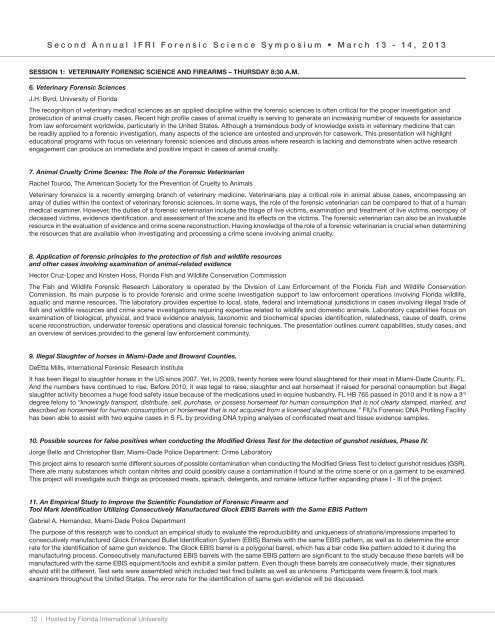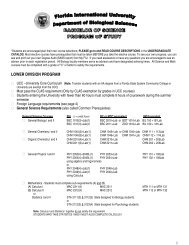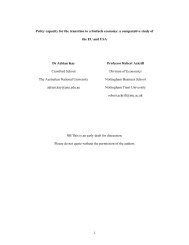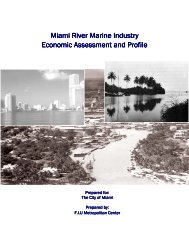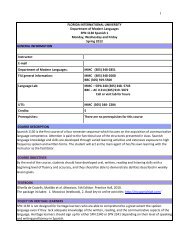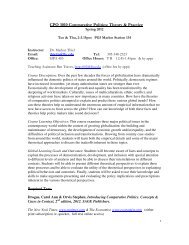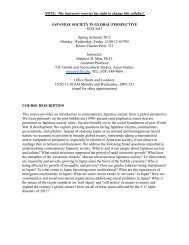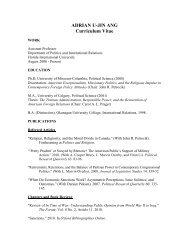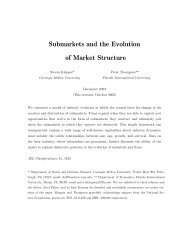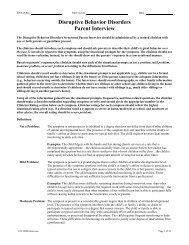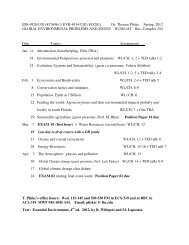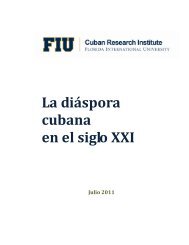Second Annual IFRI Forensic Science Symposium - College of Arts ...
Second Annual IFRI Forensic Science Symposium - College of Arts ...
Second Annual IFRI Forensic Science Symposium - College of Arts ...
Create successful ePaper yourself
Turn your PDF publications into a flip-book with our unique Google optimized e-Paper software.
<strong>Second</strong> <strong>Annual</strong> <strong>IFRI</strong> <strong>Forensic</strong> <strong>Science</strong> <strong>Symposium</strong> • March 13 - 14, 2013<br />
SESSION 1: VETERINARY FORENSIC SCIENCE AND FIREARMS – THURSDAY 8:30 A.M.<br />
6. Veterinary <strong>Forensic</strong> <strong>Science</strong>s<br />
J.H. Byrd, University <strong>of</strong> Florida<br />
The recognition <strong>of</strong> veterinary medical sciences as an applied discipline within the forensic sciences is <strong>of</strong>ten critical for the proper investigation and<br />
prosecution <strong>of</strong> animal cruelty cases. Recent high pr<strong>of</strong>ile cases <strong>of</strong> animal cruelty is serving to generate an increasing number <strong>of</strong> requests for assistance<br />
from law enforcement worldwide, particularly in the United States. Although a tremendous body <strong>of</strong> knowledge exists in veterinary medicine that can<br />
be readily applied to a forensic investigation, many aspects <strong>of</strong> the science are untested and unproven for casework. This presentation will highlight<br />
educational programs with focus on veterinary forensic sciences and discuss areas where research is lacking and demonstrate when active research<br />
engagement can produce an immediate and positive impact in cases <strong>of</strong> animal cruelty.<br />
7. Animal Cruelty Crime Scenes: The Role <strong>of</strong> the <strong>Forensic</strong> Veterinarian<br />
Rachel Touroo, The American Society for the Prevention <strong>of</strong> Cruelty to Animals<br />
Veterinary forensics is a recently emerging branch <strong>of</strong> veterinary medicine. Veterinarians play a critical role in animal abuse cases, encompassing an<br />
array <strong>of</strong> duties within the context <strong>of</strong> veterinary forensic sciences. In some ways, the role <strong>of</strong> the forensic veterinarian can be compared to that <strong>of</strong> a human<br />
medical examiner. However, the duties <strong>of</strong> a forensic veterinarian include the triage <strong>of</strong> live victims, examination and treatment <strong>of</strong> live victims, necropsy <strong>of</strong><br />
deceased victims, evidence identification, and assessment <strong>of</strong> the scene and its effects on the victims. The forensic veterinarian can also be an invaluable<br />
resource in the evaluation <strong>of</strong> evidence and crime scene reconstruction. Having knowledge <strong>of</strong> the role <strong>of</strong> a forensic veterinarian is crucial when determining<br />
the resources that are available when investigating and processing a crime scene involving animal cruelty.<br />
8. Application <strong>of</strong> forensic principles to the protection <strong>of</strong> fish and wildlife resources<br />
and other cases involving examination <strong>of</strong> animal-related evidence<br />
Hector Cruz-Lopez and Kristen Hoss, Florida Fish and Wildlife Conservation Commission<br />
The Fish and Wildlife <strong>Forensic</strong> Research Laboratory is operated by the Division <strong>of</strong> Law Enforcement <strong>of</strong> the Florida Fish and Wildlife Conservation<br />
Commission. Its main purpose is to provide forensic and crime scene investigation support to law enforcement operations involving Florida wildlife,<br />
aquatic and marine resources. The laboratory provides expertise to local, state, federal and international jurisdictions in cases involving illegal trade <strong>of</strong><br />
fish and wildlife resources and crime scene investigations requiring expertise related to wildlife and domestic animals. Laboratory capabilities focus on<br />
examination <strong>of</strong> biological, physical, and trace evidence analysis, taxonomic and biochemical species identification, relatedness, cause <strong>of</strong> death, crime<br />
scene reconstruction, underwater forensic operations and classical forensic techniques. The presentation outlines current capabilities, study cases, and<br />
an overview <strong>of</strong> services provided to the general law enforcement community.<br />
9. Illegal Slaughter <strong>of</strong> horses in Miami-Dade and Broward Counties.<br />
DeEtta Mills, International <strong>Forensic</strong> Research Institute<br />
It has been illegal to slaughter horses in the US since 2007. Yet, in 2009, twenty horses were found slaughtered for their meat in Miami-Dade County, FL.<br />
And the numbers have continued to rise. Before 2010, it was legal to raise, slaughter and eat horsemeat if raised for personal consumption but illegal<br />
slaughter activity becomes a huge food safety issue because <strong>of</strong> the medications used in equine husbandry. FL HB 765 passed in 2010 and it is now a 3 rd<br />
degree felony to “knowingly transport, distribute, sell, purchase, or possess horsemeat for human consumption that is not clearly stamped, marked, and<br />
described as horsemeat for human consumption or horsemeat that is not acquired from a licensed slaughterhouse.” FIU’s <strong>Forensic</strong> DNA Pr<strong>of</strong>iling Facility<br />
has been able to assist with two equine cases in S FL by providing DNA typing analyses <strong>of</strong> confiscated meat and tissue evidence samples.<br />
10. Possible sources for false positives when conducting the Modified Griess Test for the detection <strong>of</strong> gunshot residues, Phase IV.<br />
Jorge Bello and Christopher Barr, Miami-Dade Police Department: Crime Laboratory<br />
This project aims to research some different sources <strong>of</strong> possible contamination when conducting the Modified Griess Test to detect gunshot residues (GSR).<br />
There are many substances which contain nitrites and could possibly cause a contamination if found at the crime scene or on a garment to be examined.<br />
This project will investigate such things as processed meats, spinach, detergents, and romaine lettuce further expanding phase I - III <strong>of</strong> the project.<br />
11. An Empirical Study to Improve the Scientific Foundation <strong>of</strong> <strong>Forensic</strong> Firearm and<br />
Tool Mark Identification Utilizing Consecutively Manufactured Glock EBIS Barrels with the Same EBIS Pattern<br />
Gabriel A. Hernandez, Miami-Dade Police Department<br />
The purpose <strong>of</strong> this research was to conduct an empirical study to evaluate the reproducibility and uniqueness <strong>of</strong> striations/impressions imparted to<br />
consecutively manufactured Glock Enhanced Bullet Identification System (EBIS) Barrels with the same EBIS pattern, as well as to determine the error<br />
rate for the identification <strong>of</strong> same gun evidence. The Glock EBIS barrel is a polygonal barrel, which has a bar code like pattern added to it during the<br />
manufacturing process. Consecutively manufactured EBIS barrels with the same EBIS pattern are significant to the study because these barrels will be<br />
manufactured with the same EBIS equipment/tools and exhibit a similar pattern. Even though these barrels are consecutively made, their signatures<br />
should still be different. Test sets were assembled which included test fired bullets as well as unknowns. Participants were firearm & tool mark<br />
examiners throughout the United States. The error rate for the identification <strong>of</strong> same gun evidence will be discussed.<br />
12 | Hosted by Florida International University


